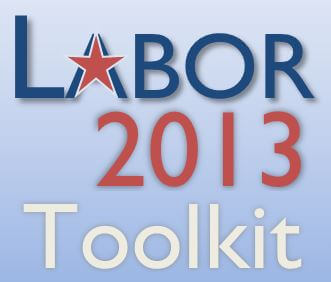Labor rights were not on the line during this off-year election cycle, at least in the traditional sense. But there were still some union victories. Bill de Blasio, of course, seems to symbolize a repudiation of Michael Bloomberg’s attempts to destroy the last vestiges of the working-class ethos that defined postwar New York.
But neighboring New Jersey also remembered its blue-collar values. True, voters resoundingly re-elected Chris Christie, a rough-and-tumble governor whose admiration for working-class icon Bruce Springsteen is well known. Christie is, of course, hardly a friend to the labor movement, which played an outsized role in keeping Christie’s coattails short.
Christie needed friendly Republicans in the legislature. His presidential ambitions are hardly a secret. Pundits are also well aware that the Democratically-controlled legislature has stopped him from signing off on the kind of laws that would appeal to the right-wingers who will come out to vote in the 2016 GOP primaries. Christie tried to engineer exactly the kind of sweeping re-election that would have given him more influence over the legislature. He scheduled the contest to replace recently-deceased Senator Frank Lautenberg just days before Election Day. Democratic challengers accordingly fought over that opening instead of fronting a serious challenge to Christie.
But the Fund for Jobs, Growth, and Security did put up a fight, largely from money that Garden State teachers’ and carpenters’ unions raised. $8 million was spent on ads, polling, and strategizing in nine crucial legislative districts where Republicans seemed poised for victory. Money also went to literally get the vote out: the fund coordinated efforts to knock on 255,000 doors across the state of New Jersey. The combined effort with the Democratic Party and the New Jersey Education Association paid real dividends: only one incumbent Democrat lost their seat.
So why is this a victory for labor? At first glance, it does not seem to be clear-cut. New Jersey Democrats (like too-many party members across the nation) have sided with conservative Republicans like Christie. These turncoats have even cast votes detrimental to the working class who still almost reflexively vote “blue.” On Tuesday, the governor also made inroads with African American, Latino, and women voters, constituents whose economic concerns often align them with the union movement’s economic policies, like raising the minimum wage. Christie, of course, vetoed just such a hike in January, arguing it “will jeopardize the recovery we all seek.”
Voters, in effect, overruled Christie. That was the real shock on Tuesday: Garden State voters signed off on the bill that Christie threw out. The measure actually passed by 61% of the vote, a percentage just a hair higher than Christie’s. Baseline pay will rise to $8.25. Future increases will also be automatic because they are tied to the consumer price index, not legislative or ballot fiat.
This overwhelming ratification signals the potency of labor politics and the movement itself. Unions have been showing themselves able to exploit the 2010 Citizens United ruling, which many pundits assumed would be a death knell to progressive grassroots politics. That was hardly the case in New Jersey, nor was it true in many of the swing states where union activists made a difference in 2012. Moreover, these races show that a partnership between the labor movement and the Democratic Party does not have to come at the expense of working people, as was too often the case in twentieth-century politics. Aggressive fundraising and spending has actually allowed unions and labor-backed PACs (like the Fund for Jobs, Growth, and Security) to take on the sort of polling, out-reach, and campaigning once solely left to the parties. Indeed, one of the most remarkable facts about the New Jersey election year: the independent spending, much of it from the labor movement, far exceeded what conservative groups were able to raise.








2 Comments
Comments are closed.